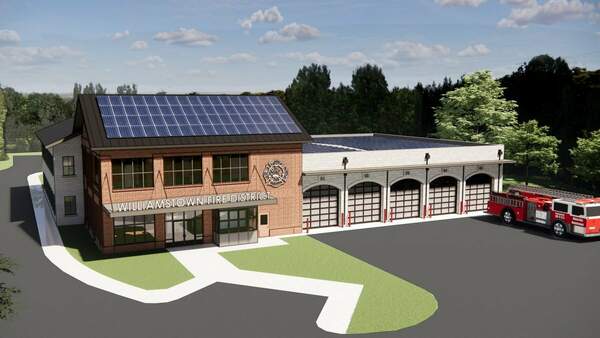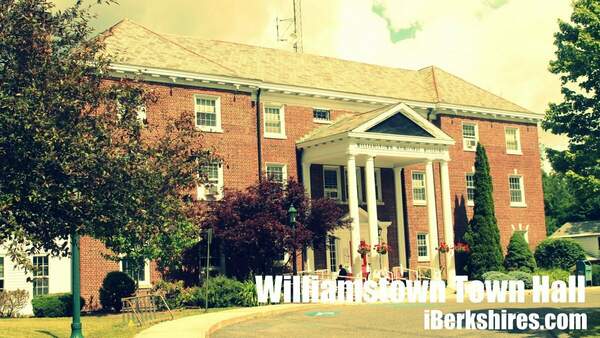The Clark Outlines Master Plan for More Growth in the Future
WILLIAMSTOWN, Mass. — The Sterling and Francine Clark Art Institute must grow in order to expand its programs and holdings, and the blueprint for that growth will stem from a master plan that is expected to be completed this fall, Clark Director Michael Conforti said last week.
Conforti outlined the master plan to about 75 listeners in the Clark auditorium last week, and elicited comments from the community.
"Every aspect of the Clark has grown dramatically in recent years," said Conforti. "Program growth without change in the physical plant is not possible much longer."
But Conforti stressed that any growth would be carefully planned to retain both the intimate atmosphere of the Clark itself and the rural beauty of its 130-acre natural campus and its natural surroundings.
Some 175,000 to 200,000 visitors come to the Clark annually — among Berkshire County cultural attractions, only Tanglewood is a bigger draw — and visitors' services are among the most pressing needs, Conforti said.
Asked later what specific plans might be in the works, Conforti said. "I do know the first building will have to include the Williamstown Art Conservation Center, and there may be other things in that space.
"In some ways, we've made the assumption that there will be more than one structure, because we very much want to keep the intimacy of space," he said.
While needs are wide-ranging — exhibition space, space for the conservation lab, more office space for an expanded staff — "definitely the very largest need of all is visitors' services needs," said Conforti, citing the expectations of visitors.
Conforti listed the aims as: to maintain the important landscape here, the meadow with views out from Stone Hill; keep the intimate atmosphere of the Clark itself; find seasonal parking; provide access to Stone Hill, and "find space for those things that we are not providing the right kind of space for at present, such as visitors' services and gallery space."
Visitors' services, he said, might be in a different building than the present one. They are now set around in the large entrance hall.
"The potential change is great," said Conforti. "In a 10- to 20-year period there could be surprising changes. There's the potential for a variety of changes. That's all we can say right now because that's all we know right now."
The Clark has engaged the New York-based planning firm of Cooper, Robertson, and Partners, to prepare the plan. At Friday's gathering Don Clinton from Cooper, Robertson outlined issues of land use and conservation, using maps of the area.
Said Conforti, "The event was to elicit community input in the process. We want people to tell us what they would and would not like to see happen."
People who would like to express their opinions may call Sherrill Ingalls, public relations coordinator at the Clark, 458-2303 ext. 508; or, in the community, attorney Donald Dubendorf, 458-3868; or Henry and Mary Flynt, 196 South St., 458-4236.
"This is more a story about planning than about what the Clark is going to do. There's such a collective interest regionally in planning," Conforti said. "I really want the Clark to be kind of a model of community involvement."
The Clark is now engaged in fact-finding, space analysis and understanding the dynamics of the property.
"I think Stone Hill is almost like a town park," he said. "It's sited between two roads, Route 43 and Route 7, and it's the entrance to an 18th-century road."
Conforti said he has talked with the directors of both the Williamstown Rural Lands Foundation and the Berkshire Natural Resources Council who favor greater, easier access to Stone Hill for the townspeople and visitors to the Clark.
"Right now, we access Stone Hill around the maintenance building and through a sometimes muddy trail. What I'm interested in is seeing guests of the museum feeling comfortable and finding it easy to walk up from the museum to the hill.
"It's a complex site," he continued. "There are 130 acres, but when you add to that the realities, there's very little land you could or would want to put buildings on. The lower part has a pond and wetlands, and the parking needs are seasonal — we need them only in the summer months — so we want gravel fields, as they have at Tanglewood. It's a very, very tricky process."
"It's not an easy place to think about building things."
At present, overflow parking is in a sometimes muddy wood-chip lot, from which visitors must reach the museum by crossing a driveway. Although some suggested underground parking, Conforti said expense and use of space might not be warranted because the need is seasonal.
Conforti said in addition to acquiring the house formerly belonging to the late Penelope Corbin, the Clark has just acquired the adjacent property that belonged to the late Harry and Leona Kalker, and are entering into an agreement to eventually acquire the Wall property on South Street.
Conforti said the master plan for the preservation and development of the Clark is evidence of "our commitment to community leadership, conservation and stewardship. As the Clark enters its 45th anniversary year, we are just beginning to understand where we need to grow."
He stressed the Clark's role as a major economic force as part of the cultural tourism mix in Berkshire County. In February, the Massachusetts Cultural Council awarded the Clark a $64,000 grant to support exhibitions, education and research programs, the first time the Institute has received operating support from the state.
"The Clark has a special two-part mission: as an art museum and as a research and academic center," said Conforti. "We have decided to step back and analyze our growth and in the process are investigating the appropriate balance of the needs of the Institute and the natural landscapes."
Conforti used the upcoming exhibition "Noble Dreams, Wicked Pleasures: Orientalism in America, 1870-1930" to illustrate the Clark's "role as an art museum and its mission as an incubator of new ideas."
"We have to look at more gallery space," said Conforti, particularly because the Clark expects the donation of a collection of American paintings and decorative arts, now on loan, from the descendants of George Cluett, and early glass from Mrs. Alfred Lauzon, as well as the recent donation of silver from Mrs. H. Morris Burrows.
The Clark is organizing an exhibition titled "Impression: Painting Quickly in France 1860-1890," which will open in London and come to the Clark in June, 2001.
In addition to its attendance, which has increased some 50 percent to 75 percent over the past five years, staffing has grown by 50 percent, and membership is up 75 percent.
The Cooper, Robertson firm has worked at Monticello, Thomas Jefferson's home in Charlottesville, Va., at the Cleveland Museum and the Museum of Modern Art in New York City.
Clark Trustees Chairman Francis C. Oakley called the master plan "a very dynamic moment in the history of this distinguished institution."
Dagmar Bubriski of Hoxsey Street said "one of the great, great assets of the Clark is that visitors are able to look out windows and admire the landscape. But we have had some windows closed."
Bubriski urged the Clark to keep those views, saying "the view is as good as the paintings."
As for the need for access to Stone Hill and the surroundings, Bubriski said "I don't think there's any problem with their seeing and enjoying it."
And Bubriski said she objects to what she called "billboards," (and the Clark, and the town sign commission, considers directional signs), because, she said, they obstruct views.
William H. Pierson Jr., of 107 South St., retired professor of art history at Williams college, spoke of his longstanding relationship with the Clark by saying, "I will be very resentful of anything the Clark does that upsets that relationship.
"I hope any buildings that are going to be built have a sense of scale, and that they modulate into the landscape."
Tags: Clark Art,

 WILLIAMSTOWN, Mass. — The Prudential Committee on Wednesday signed off on more than $1 million in cost cutting measures for the planned Main Street fire station.
WILLIAMSTOWN, Mass. — The Prudential Committee on Wednesday signed off on more than $1 million in cost cutting measures for the planned Main Street fire station.













